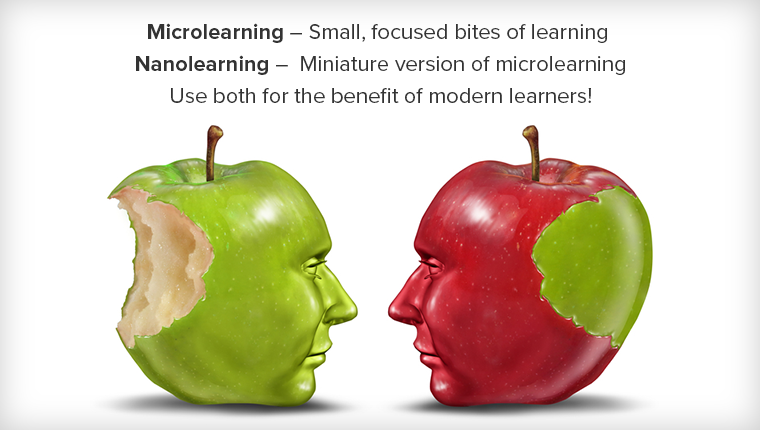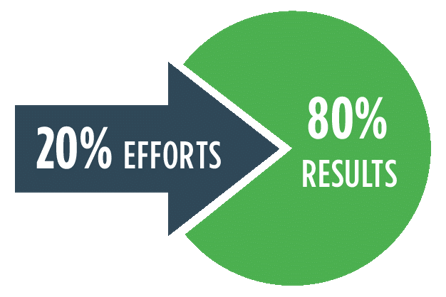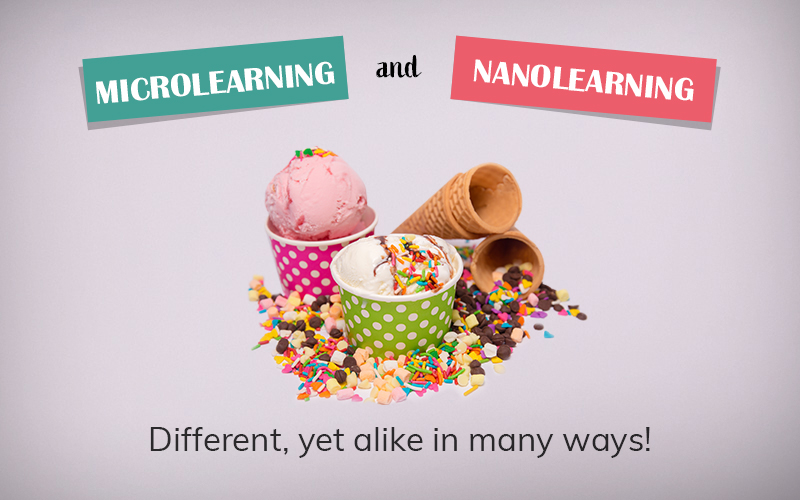Are Microlearning and Nanolearning the Same?

Today’s corporate world demands that employees keep switching from task to task to meet the demands of the workplace. This results in learning and development often taking a backseat. Also, when employees fail to see value in training, they are more likely to play truant. Smart organizations have realized that one way to tackle this problem is to incorporate learning in the flow of work, and this can be done through microlearning and nanolearning.
What exactly are microlearning and nanolearning? We see these terms often being used interchangeably. Are they the same?
What are Microlearning and Nanolearning?
According to an article published in the International Journal of Educational Excellence, there are two new branches derived from eLearning, and they are microlearning and nanolearning.
Microlearning refers to small nuggets of learning that are very effective in imparting knowledge and skills to employees.
According to an ATD article, the most effective length for a microlearning activity is longer than 2 minutes but shorter than 5 minutes. However, in reality, a third of microlearning used in organizations was between 10-15 minutes long.
Are Microlearning and Nanolearning Similar?
Microlearning and nanolearning are considered branches of eLearning and they share the following similarities:
- Ideal for modern learners
- Designed for effective knowledge transfer
- Based on the Pareto principle
- Encourage spaced repetition
- Provide budget-friendly training options
Nanolearning is similar to microlearning, except that it can be termed a miniature version of microlearning. For example, a 90-second video that shows an expert demonstrating a task/skill can contribute to an effective nanolearning experience.
How is Nanolearning Used?
Not every learning experience requires a microlearning module of 2-5 minutes. For instance, if you want to teach learners an enabling objective, nanolearning is a good idea. Consider a training on Excel where you have to teach learners several small tasks that can become nanolearning experiences. The tasks could be:
- Calculating the sum of values in a range of cells
- Applying a formula across columns
- Creating a pivot table
Each of these tasks might take less than 2 minutes and learners can have the option of choosing the nanolearning they need.
That being said, it’s essential to understand that nanolearning cannot be used for comprehensive training, nor will it work when you’re teaching learners something for the first time. For learners who need a quick refresher on workplace related tasks, nanolearning can certainly come in handy.
Nanolearning is very effective for learners who want to learn exactly at their moment-of-need. And what’s interesting is that it takes less than 2 minutes of their time. We found this article on nanolearning from Elliot Masie an interesting read. It gives you more information on applying nanolearning in different types of training.
While microlearning can fit into formal and informal learning experiences, nanolearning is usually apt for informal learning.
For rapid eLearning techniques on microlearning development, check this free webinar.
What Makes Microlearning and Nanolearning Similar?
1. Ideal for Modern Learners
According to Bersin by Deloitte, modern learners are able to spare just 1% of a typical work week on learning and development, which is approximately 5 mins per day in a work week. How can we help these employees learn more effectively?
For busy, modern learners who have very little time to dedicate to continuous learning, microlearning and nanolearning work very well. What’s nice about these training strategies is that learners can consume these learning nuggets on the go using mobile devices of their choice such as smartphones and iPads.
2. Designed for Effective Knowledge Transfer
Are microlearning and nanolearning designed for effective knowledge transfer? Absolutely, as both of them are focused on a single learning objective (most often, a performance-based learning objective).
Some of you might question “What can happen in 5-10 minutes of training?” Let me ask you, “What can happen in 1 hour of training?” Normally, the main points of the training can be summarized in 5 to 10 mins. This is not to say we skip lengthy training programs. We definitely need those training modules. But when it comes to reinforcing concepts or providing support exactly at the learners’ moment-of-need, it would make sense to consider nanolearning or microlearning.
Learning in the flow of work turns into a reality when you’re able to rollout training in short nuggets. And these bite-sized nuggets of learning guarantee higher retention rates of learning.
3. Based on the Pareto Principle
Both microlearning and nanolearning are based on the Pareto principle. Applying the Pareto’s principle for learning and development, 80% of learning can happen by applying 20% of your effort in a learning activity.

Even if these two innovative training strategies do not exactly fit the 80-20 distribution in a Pareto framework, we cannot deny the fact that they result in considerable cost savings and are very effective in teaching employees. For instance, a 2-minute video that shows an expert demonstrating a task or an infographic that lists the steps to be followed in a process are bound to be more effective when learners are looking for a quick reinforcement of training.
4. Encourage Spaced Repetition
The use of microlearning and nanolearning allows learners to choose content that’s exactly aligned with their learning needs. They can pick specific pieces of learning, while skipping content they already know. If you want to avoid learners from going through time-consuming comprehensive training material, micro or nano is the way to go! Another advantage of using these short training modules is that they facilitate spaced repetition.
You get employees to go through many training programs – you end up overwhelming them. You make training a half-yearly or annual event, then learning becomes just that – an event. There’s no effective learning that’s happening. So how much training is just right for your employees? This is a challenge training managers often face.
With spaced repetition, it is possible to provide a sticky learning experience. Bite-sized learning modules are designed for quick and easy spaced repetition.
5. Provide Budget Friendly Training Options
There are times when training budgets are tighter than expected. However, that doesn’t mean we stop training employees. Your expert employees who have the required set of skills can share it with others who need those skills. A simple video or a mini podcast can be an effective format to share knowledge quickly. Come to think of it, it could even be a simple PowerPoint deck that an SME has created.
Getting this converted to a micro or nanolearning experience is something that can be managed within your training budget.
Wrapping it Up
It’s baffling when employees demand opportunities to learn, yet refuse to complete training when it’s handed to them on a platter – only because of a lack of time. Timely training matters for effective employee learning and development. When you provide training at the learners’ point of need, they certainly are going to be more receptive to the learning experience. With microlearning and nanolearning, this training can be completed within minutes – so lack of time to devote to training is no longer an excuse.
If you’d like to know more on incorporating microlearning in your training strategy, download our eBook on Microlearning now!





![4 Ways to Create Microlearning for your Sales Training [Infographic]](https://blog.commlabindia.com/hubfs/Imported_Blog_Media/microlearning-for-sales-training-infographic.png)